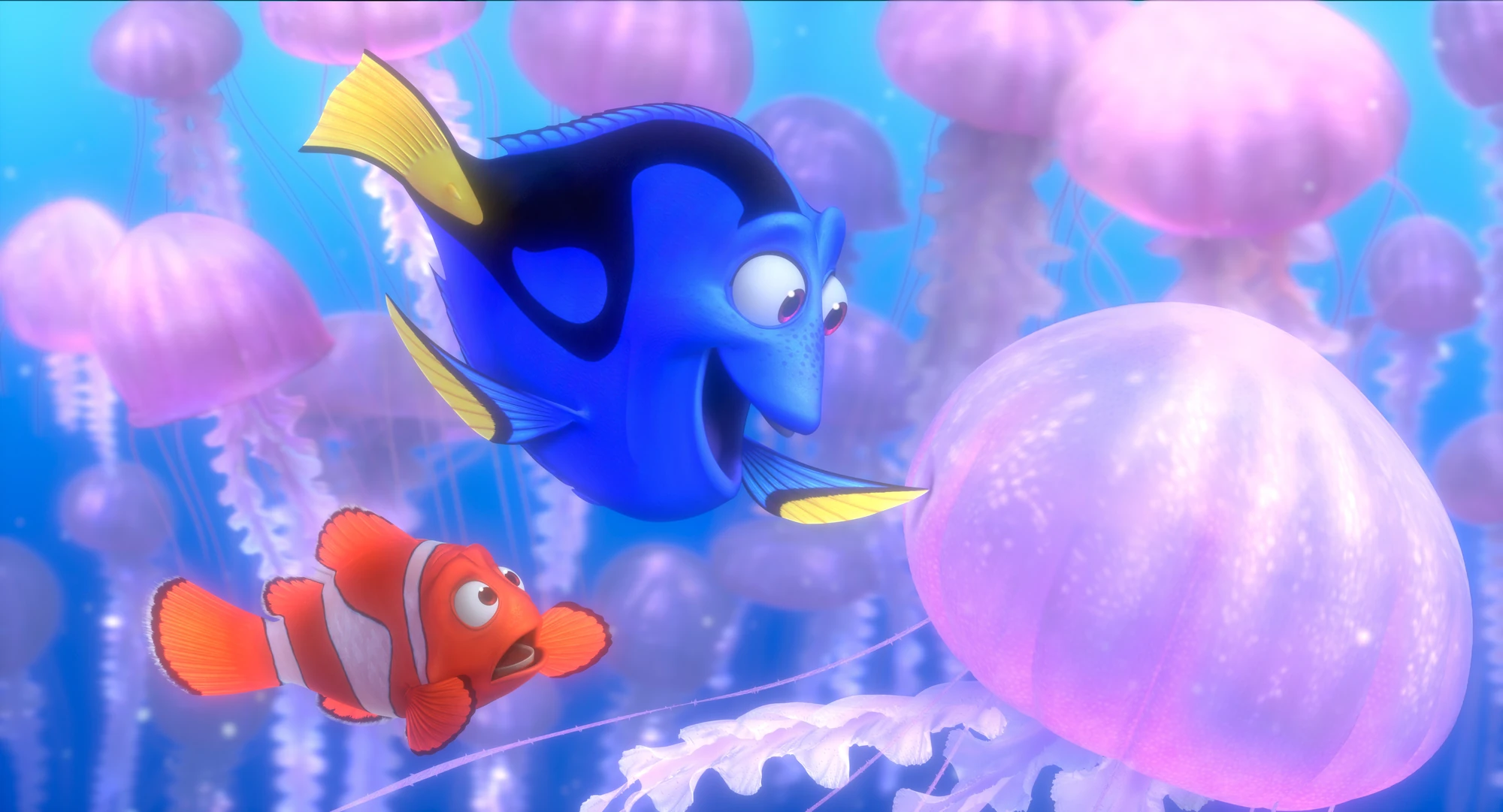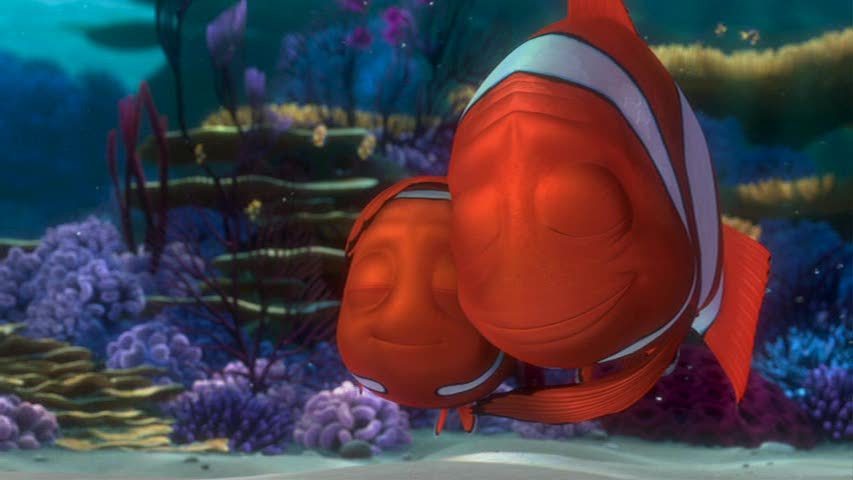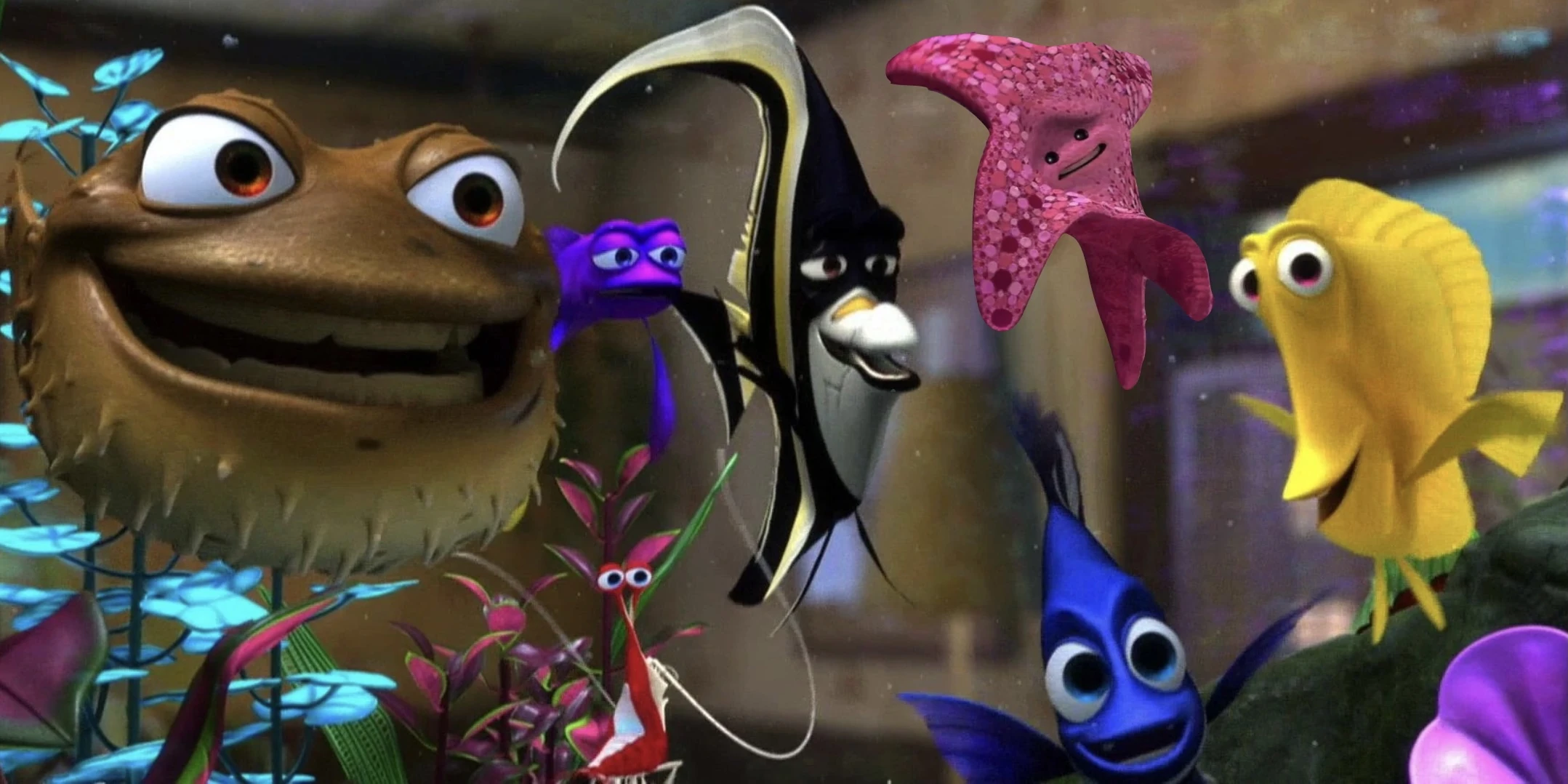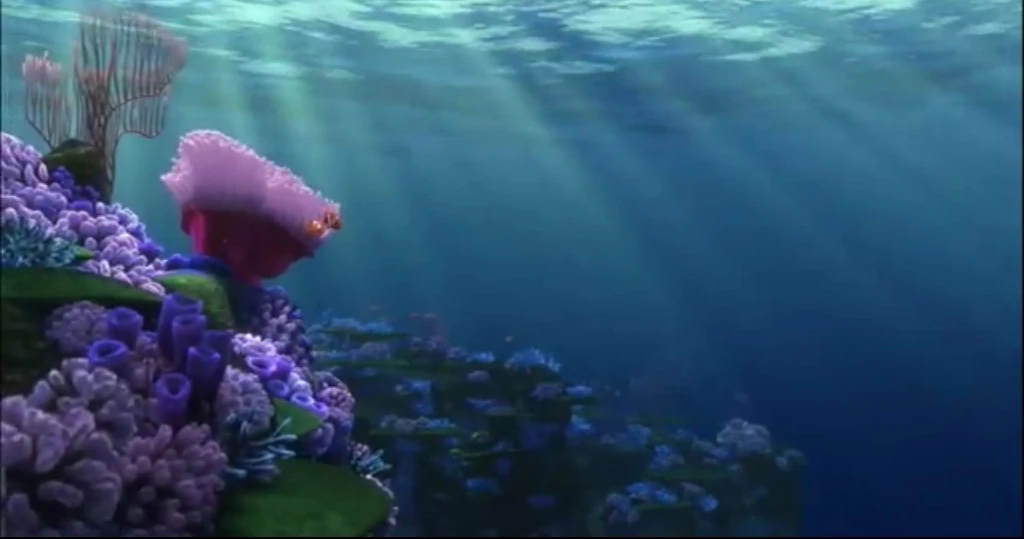I remember Finding Nemo being kind of a big deal. Not only is it one of the most critically-acclaimed installments in Pixar's filmography to this day, but back then, it outgrossed The Lion King as the highest-grossing animated film of all time. It's not until a year later that Shrek 2 outgrossed it, but that's a different story altogether. When I talk to people about Finding Nemo, they tend to have very fond memories of it, as do I.
The film played a huge part in my childhood. I remember first seeing it with my dad in the same theater where I watched A Bug's Life, the first movie I ever watched on the big screen. I watched it various times on VHS (you guys remember that video format, right?) until I was a pre-teen because the tape actually broke in one scene. It was a sad day, but I would since own a Blu-Ray copy of it years later. I also remember renting the PS2 game from Blockbuster, as well as owning the Game Boy Advance version which was different altogether. When I was in third grade, I recall illustrating a lot of the characters, even the minor ones, which showed how much I was into the film.
While I loved this movie as a child, I grew to appreciate it even more as an adult. I still say that the movie as a whole holds up after thirteen years. Its characters are a lot of fun, it still makes me laugh, it still looks beautiful to this day, and these past few years, I grew into the emotional core of the film.
We all know what it's about. A clownfish named Marlin (voiced by Albert Brooks) conquers the ocean to search for his son, Nemo (Alexander Gould) who was taken away by divers.
The first few minutes perfectly establishes his character arc in which he becomes the overprotective father we know in the rest of the movie. Right at the beginning, it starts with his mate and their 400+ unhatched offspring getting eaten by a barracuda off-screen. This probably frightened a lot of children on their first viewing, but I applaud Pixar for not holding back in showing the dangers of the ocean, a recurring theme in the film.
It's there that Marlin finds the surviving egg, which he names Nemo, a name that his mate really liked, and tries his darnedest to protect him. This, however, comes at a price. In his introductory scene where Nemo tells his dad he wants to go to school, it is greatly established that they do love each other, but Nemo is not quite fond of Marlin's fear of the ocean. Notice how their relationship does not make either of them that they're in the wrong because each one has their reasons. Marlin does not want to be alone, whereas Nemo wants to be able to do things on his own. When Nemo gets taken away, both of them feel like it is their own fault. It is such a well-written father-son relationship and it stars a bunch of fish.
One of the main characters who Marlin comes across on his journey is a blue tang fish named Dory (voiced by Ellen DeGeneres). She is one of the best comic relief characters in film history. Still to this day, I enjoy her singing "Just Keep Swimming" and I can't get enough of her whale talk. That moment right there was where the animators had a lot of fun making hilarious facial expressions, like this one...
Her most notable trait is that she suffers from short-term memory loss. When they first meet, she takes him to where she claims she saw a boat coming around and then realizes he is following her. In addition, she is also pretty naive, always liking to play games or just fool around, but never to the point where she is annoying, something which can be pretty difficult when writing comic relief characters.
What's also great about Dory is that she has a lot of depth. While she has this kind and playful facade, she has a sense of loneliness. She can't remember her friends and family before the events of this film, adding some mystery. Of course, we'll get to learn a little bit about her in the upcoming sequel Finding Dory, but that's a post for another time.
Both Marlin and Dory have pretty good chemistry with one another. Their interactions are some of the funniest that I have seen in a Pixar movie. Marlin's maturity and Dory's childishness make them great foils for each other. Plus, despite being a male/female pairing, they do not become a couple in the end. Their relationship is strictly platonic throughout, which is a good thing. It's not because that they are both different species, it's that Marlin has a lot on his mind concerning Nemo, so finding a romantic partner would just unnecessarily slow the film down.
Another great character the film has is the sea turtle Crush, voiced by director Andrew Stanton. Yes, he speaks in a stereotypical surfer dude accent. Yes, he says "Dude" more times than Soos from Gravity Falls. But, by gosh, is he a lot of fun to watch every time he is on screen. Not just that, he plays a part in Marlin's character development as evident in the scene where he witnesses his son, Squirt, swim all by himself when he thought he couldn't. This piece of dialogue helps, too:
Marlin: How do you know when they're [the baby turtles] are ready?
Crush: Well, you never know, but when they know, you'll know, you know.
On Nemo's side of the story, he is held inside a fish tank inside a dentist's office, waiting to be a birthday present for this little girl named Darla. He is accompanied by the Tank Gang, led by a Moorish idol named Gill (voiced by Willem DaFoe). Each individual has an identifiable trait. There's Bubbles' obsession with... bubbles; there's Deb, who thinks her reflection named Flo is her sister; and there's Gurgle's fear of germs.
Actually, now that I think about it, the loads and loads of characters, even the minor ones, have something about them that make us remember who they are. I remember the young seahorse, Sheldon, who sneezes because he is "H2O intolerant." I remember this blue, buck-toothed fish with a lisp. I remember that tiny, big-eyed fish who escapes the sharks' meeting out of fear, only to come back in the post-credits scene for something amusing. A lot of care was put into giving these background characters a lot of personality.
Back to Nemo and Gill, their friendship is another thing that stands out. Right off the bat, both of them have some form of physical disability or scarring. Nemo has a smaller right fin and Gill is scarred because of his one escape attempt, which tightens their connection. Gill is like a parental substitute for Nemo the same way Marlin is sort of a parental substitute to Dory, but with some differences.
There were two instances where Nemo gets stuck in something. The first time, Marlin gets Nemo out of some coral, claiming he will never get out of there himself. In Nemo's first scene with Gill, he gets stuck in a pipe, but Gill encourages him to get out without help, to which he succeeds. I guess Marlin and Gill also serve as great foils for one another because of this.
When it comes to the Tank Gang, it's clear that the film has a negative stance towards keeping fish as pets. Gill even says, at one point, that fish are not meant to be in a box, because it does things to them. This explains why almost the rest of the fish in the tank are a little insane or quirky. They even develop a fear of Darla, who they deem as a "fish killer," because she would not stop shaking her bag which had a fish inside.
This only made things a little more depressing in real life. I've heard stories of people wanting to keep clownfish as pets, which went against the message of the film. I've even heard that there is a decrease in the clownfish population after the film's release. When that is not happening, there were people who tried to put fish back into their natural habitat by either flushing them or putting them in the wrong body of water. It's... uh, not good, so I'll transition into something less depressing.
I quickly mentioned that Marlin is sort of a parental substitute to Dory. He does get a bit annoyed with her short-term memory loss, but he otherwise cares for her. The reason I think of this is because of the scene where they were about to be swallowed by a whale. Just before they enter its throat, Marlin lacks trust in Dory, who claims she can speak whale. Marlin then repeats a line from earlier, almost word for word:
"You think you can do these things, but you can't, Nemo!"
Right after he says that, Marlin pauses. It's never discussed again, but from that one shot, we see Marlin's face as he realizes what he is becoming to Dory the same way he was to Nemo. Thus, he earns his character development when he decides to take a leap of faith as they are swallowed by the whale... and make it out alive through its blowhole. That is crazy right there.
The one thing that surprised me as a kid was that there was no clear villain. There is a term on TV Tropes called "white and grey morality." While the protagonists are definitely the good guys, the "bad" guys aren't really "bad" per se, for different reasons. Predators like the seagulls, the barracuda, and the anglerfish are just predators by nature, doing what they can to survive. When I watched the ads for the film, they constantly showed the shark, Bruce, who I thought would be the main antagonist, but it's proved otherwise. In addition to his short amount of screen time, he's just a predator trying to overcome this natural instinct.
What about the dentist? I suppose he's the closest thing to an antagonist, but he loves fish and he took Nemo only because he thought he was lost and struggling for life. His niece, Darla, is just a child who doesn't know any better. She doesn't know that shaking a bag is harmful to fish. Plus, you can tell how sad she was in losing Nemo when he went down the drain. White and grey morality is something that is rarely seen in family movies, so this was quite a change of pace.
 As I've mentioned before, Finding Nemo is genuinely funny. It's not obnoxious so as to pander to children and make adults groan. It's guaranteed to make older and younger audiences laugh thanks to its great lines, some juvenile humor that works, and some humor that will fly over the kids' heads ("Think dirty thoughts"). And that's one other thing I have to mention: this movie is quotable, right up there with Gone with the Wind, The Princess Bride, anything that people can quote from. I can tell that a lot of kids can memorize "P. Sherman, 42 Wallaby Way, Sydney" no problem, or constantly quote things like "Fish are friends, not food" or "He touched the butt." I remember that as a child, I would recite lines from the movie no problem, which only goes to show how well-written it is.
As I've mentioned before, Finding Nemo is genuinely funny. It's not obnoxious so as to pander to children and make adults groan. It's guaranteed to make older and younger audiences laugh thanks to its great lines, some juvenile humor that works, and some humor that will fly over the kids' heads ("Think dirty thoughts"). And that's one other thing I have to mention: this movie is quotable, right up there with Gone with the Wind, The Princess Bride, anything that people can quote from. I can tell that a lot of kids can memorize "P. Sherman, 42 Wallaby Way, Sydney" no problem, or constantly quote things like "Fish are friends, not food" or "He touched the butt." I remember that as a child, I would recite lines from the movie no problem, which only goes to show how well-written it is.Apart from its comedy, I have to give Nemo credit for how much it hits people emotionally. Despite having a lot of comedic moments, this is one of Pixar's most dramatic films. It's a film about child kidnap, so you know what's going down. On my recent viewing before writing this review, my eyes were starting to well up in the scene near the climax. It was bad enough when Marlin was at his lowest point just losing all hope thinking Nemo was gone forever, but then comes Dory. Ellen DeGeneres gave it her all when Dory talks about how Marlin means to her because she can remember things better with him. You know something was done right when DeGeneres herself cried after giving this performance.
Speaking of tearjerker scenes, the score deserves a big mention. This is the first Pixar film to not be composed by Randy Newman. Instead, the role of composer went to his cousin, Thomas Newman, who composed films like The Shawshank Redemption and American Beauty. His film scores are often bittersweet, melancholic, and soothing, almost like I'm at peace when listening to it. It's quite a contrast to Randy Newman's scores, which are always upbeat and lighthearted.
When I was a child, I didn't quite have an appreciation towards film scores like I do today, since I often listened to music that had singing. It wasn't until I rented the soundtrack from my local library that I slowly began to expand my taste in music with film scores. When I listen to "Main Titles: Nemo Egg," I get chills down my spine thanks to its excellent use of piano and strings, instruments that Newman often uses.
Another favorite track of mine is "Field Trip," which plays when Nemo and the other school fish are traveling the reef with Mr. Ray. The piano and flutes help make the audience just see the beauty of the ocean thanks to its many sights and seeing the different types of fish that inhabit it. From that moment on, the audience is immersed into this beautiful world. There are many motifs that I could just hum over and over again, which is what, in my opinion, makes for a great score.
I haven't even begun to talk about the animation: it's gorgeous and it still holds up after many years. You could take any shot that shows off the scenery and just hang it up as a picture. The animators spared no expense in making one of the most highly-detailed animated films of all time. The color palettes, the light reflecting on surfaces whenever something takes place underwater, and the tiny specks that float everywhere makes the viewer feel like they're underwater.
Watching it on Blu-Ray made me look at details that I had never seen before, like the scales on Marlin and Nemo and the slits on both of Dory's sides which are supposed to be gills. When Darla was tapping the fish tank, her fingerprints were visible and started to fade after one second. You can tell that the technology came a long way after Toy Story and would only evolve even further with other great-looking CGI films like The Incredibles, How to Train Your Dragon, and Tangled, to name a few.
That's not to mention that the animation on each of the characters is pretty spot-on. Each creature has their own unique way of moving, like Nemo's little fin that flaps really fast, or Dory making wavy movements when swimming, or Jacques (the shrimp) swimming by paddling his legs. It's the little touches that show that the animators did their homework on how different types of sea creatures move.
My one goal in this review is to set aside my nostalgia and look at it as an adult who is beginning to look more closely at filmmaking and story structure, all that jazz. I try to make some sense out of everything while also looking for some things that do not work, because no movie is perfect.
On my recent viewing, I realized that the only weak part that I can think of is the climax near the end at the fishing grounds. It's a good scene, believe me. If anything, it tests Marlin's trust towards Nemo about being able to do things on his own. The reconciliation between between the two ("Dad... I don't hate you") is still pretty heartwarming. I just felt that the filmmakers tried to come up with something to not leave it on an anti-climactic note, and the fishing net scene doesn't quite match the weight of the rest of the movie. Still, the good outweigh the bad.
 That's about it. I've done a lot of gushing towards this film. There are so many things to like that makes Finding Nemo one of Pixar's greatest films. The characters are memorable, the story is dark and dramatic, the comedy is genuinely funny, the score is phenomenal, and the animation is breathtakingly beautiful. Given how the story centered around Marlin and the search for his son, it's a film that will most definitely resonate with parents. It provides a good lesson to not be overprotective and to know when one's child can be able to things on his/her own. It's a film that will stand the test of time with all these reasons as to why it is so great.
That's about it. I've done a lot of gushing towards this film. There are so many things to like that makes Finding Nemo one of Pixar's greatest films. The characters are memorable, the story is dark and dramatic, the comedy is genuinely funny, the score is phenomenal, and the animation is breathtakingly beautiful. Given how the story centered around Marlin and the search for his son, it's a film that will most definitely resonate with parents. It provides a good lesson to not be overprotective and to know when one's child can be able to things on his/her own. It's a film that will stand the test of time with all these reasons as to why it is so great.With all that in mind, I guess you guys can predict what my final rating is. Finding Nemo is...
SOMETHING WONDERFUL
Finding Dory is just around corner and it has a lot to live up to. Tune in next time as I cover that film.





No comments:
Post a Comment